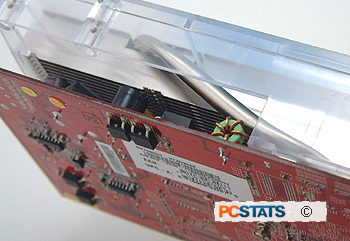 |
| Overclocking Results: |
|
|
Having never overclocked
an nVidia GeForce 7600GT class videocard we didn't really know
what to expect from the MSI NX7600GT-VT2D256E. Starting with the core first, we
used nVidia nTune to increase its clock speed from 540 MHz on up....
Increasing the clock speed in 5-10 MHz intervals, the
Geforce 7600GT core easily broke the 600 MHz barrier. Nice. Overclocking
continued and eventually the GeForce 7600GT core settled on 647
MHz as its maximum speed. That's
a pretty healthy overclock from the stock of 540MHz.
 Next up was the 256MB
of GDDR3 memory. Clocked at a swift 1.4 GHz by default, its speed was also
increased in 5-10 MHz intervals.
Next up was the 256MB
of GDDR3 memory. Clocked at a swift 1.4 GHz by default, its speed was also
increased in 5-10 MHz intervals.
The GDDR3 memory easily passed the 1.5 GHz barrier and
almost cracked the 1.6 GHz barrier as well.... but not quite. The memory
settled for a top speed of 1587 MHz.
Unfortunately the core and memory would not run together
with each at its respective maximum speed. When we tried this the videocard would crash
while running benchmarks. Those of you who have played with GeForceFX series videocards
will probably remember how difficult it was to find the top
core and memory speeds, the situation with Geforce 7600GT is reminiscent of this.
After some fiddling around, we settled on a 7600GT GPU overclocked speed of
626 MHz and a GDDR3 overclocked speed of 1568 MHz in order to complete
benchmarks without any issues.
Prelude to
Benchmarks
The details of how the MSI NX7600GT-VT2D256E
test system was configured for benchmarking; the specific hardware,
software drivers, operating system and benchmark versions are indicated
below. In the second column are the general specs for the reference platforms
this nVidia GeForce 7600GT based videocard is to be compared against. Please
take a moment to look over PCSTATS test system configurations before moving on
to the individual benchmark results on the next page.
 |
| PCSTATS Test System Configurations |
|
|
